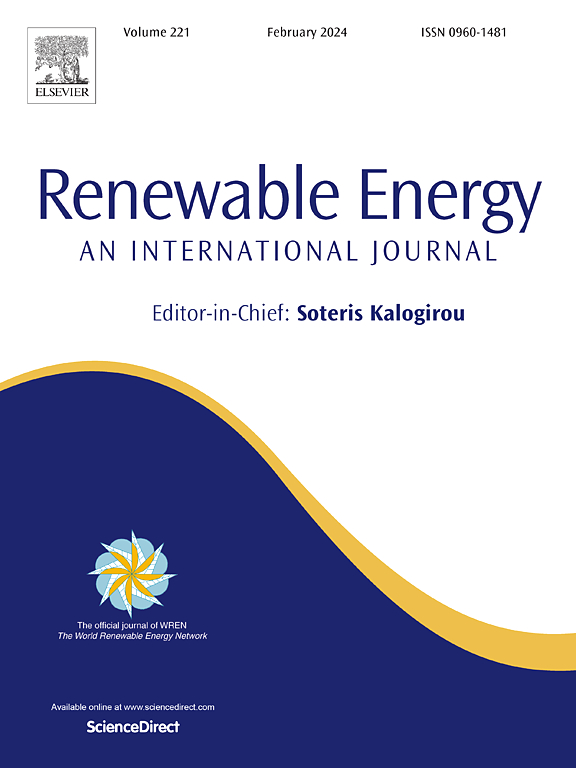间接太阳能热甲醇蒸汽重整稳定制氢的研究
IF 9
1区 工程技术
Q1 ENERGY & FUELS
引用次数: 0
摘要
间接加热太阳能反应器可以消除太阳辐射波动对反应器的影响,实现连续稳定的制氢。为了研究不同传热流体和流动方式对反应器性能的影响,本文首先建立了一个三维数值模型来分析间接加热反应器内的传热传质过程。太阳能热油(STO)具有良好的流动性和储热性能,比熔盐和热空气更适合于间接加热的甲醇蒸汽重整反应器。逆流布置反应器的甲醇转化率和热效率均高于共流布置反应器。随后,在逆流布置的间接STO加热反应器上,进一步实验分析了STO入口温度、质量小时空速(WHSV)、汽甲醇摩尔比(S/C)对甲醇转化率、产氢率和CO选择性的影响。并采用方差分析法对操作参数进行优化。结果表明,提高进气温度和S/C,降低WHSV和催化剂粒径均能提高甲醇转化率。与其他因素相比,STO进口温度对反应器性能响应的影响最大。在STO入口温度为553K, WHSV为1.78 h−1,S/C为1.3的最佳条件下,反应器的甲醇转化率为92.15%,产氢率为53.87 ml min−1∙g−1,CO选择性为5.80%。本文章由计算机程序翻译,如有差异,请以英文原文为准。
Study on stable hydrogen production by indirectly solar thermal methanol steam reforming
The indirectly heated solar reactor can eliminate the effect of fluctuating solar radiation on the reactor for continuous and stable hydrogen production. In order to investigate the effects of different heat transfer fluids and flow arrangements on reactor performance, this paper first established a three-dimensional numerical model to analyze the heat and mass transfer process in the indirectly heated reactor. Solar thermal oil (STO), which has both good fluidity and thermal storage properties, is more suitable for the indirectly heated methanol steam reforming reactor than molten salt and hot air. The reactor under counter-flow arrangement achieved higher methanol conversion and higher thermal efficiency than under co-flow arrangement. Afterwards, based on the indirectly STO heated reactor with counter-flow arrangement, the effects of STO inlet temperature, weight hourly space velocity (WHSV), molar ratio of steam to methanol (S/C) on methanol conversion, hydrogen production rate, and CO selectivity were further experimentally analyzed. Also, the operating parameters were optimized by Analysis of Variance method. The results indicated that increasing the STO inlet temperature and S/C as well as decreasing the WHSV and catalyst particle size both improved methanol conversion. Compared to other factors, STO inlet temperature had the largest significance on the reactor performance responses. Under optimal condition with STO inlet temperature of 553K, WHSV of 1.78 h−1 and S/C of 1.3, the reactor obtained methanol conversion of 92.15 %, hydrogen production rate of 53.87 ml min−1∙g−1 and CO selectivity of 5.80 %.
求助全文
通过发布文献求助,成功后即可免费获取论文全文。
去求助
来源期刊

Renewable Energy
工程技术-能源与燃料
CiteScore
18.40
自引率
9.20%
发文量
1955
审稿时长
6.6 months
期刊介绍:
Renewable Energy journal is dedicated to advancing knowledge and disseminating insights on various topics and technologies within renewable energy systems and components. Our mission is to support researchers, engineers, economists, manufacturers, NGOs, associations, and societies in staying updated on new developments in their respective fields and applying alternative energy solutions to current practices.
As an international, multidisciplinary journal in renewable energy engineering and research, we strive to be a premier peer-reviewed platform and a trusted source of original research and reviews in the field of renewable energy. Join us in our endeavor to drive innovation and progress in sustainable energy solutions.
 求助内容:
求助内容: 应助结果提醒方式:
应助结果提醒方式:


